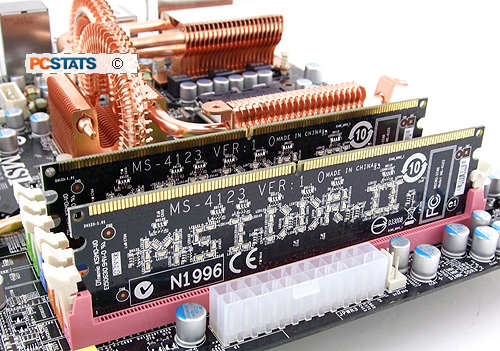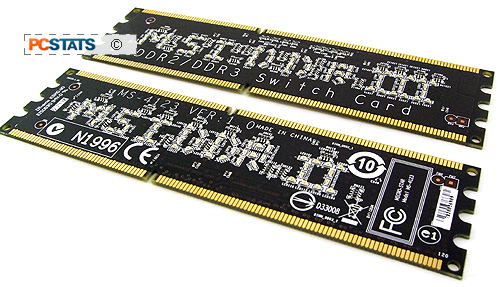Motherboards that support two memory types are always pretty popular because they allow
you to straddle the memory line until prices come down, or
you actually need the newer memory standard. With the Intel P35 Express chipset, users have two
memory options; DDR2 and DDR3 RAM. The latter is certainly the future-proof option although it
is still somewhat costly, while the former is firmly on the road
to obsolescence as far as Intel processors are concerned. The reality
for consumers weighing the benefits of a DDR3 or DDR2-based Intel motherboard,
the choice primarily comes down to cost.
As with
past periods of memory transition, motherboard manufacturers have made sure there are a couple boards
out on the streets which support either DDR2 or DDR3 memory. When you're ready for a quad
core processor and DDR3 prices have come down to earth, you can switch.
In this
review
PCSTATS is pleased to be testing MSI's P35 Platinum Combo motherboard, an Intel P35 Express and
ICH9R platform that supports both DDR2 and DDR3 memory
formats (though not at the same time). The MSI P35 Platinum works with 45nm
Intel Core 2 Duo and Core 2 Quad processors, and every other socket
775 chip that runs on a 800/1066/1333MHz Front Side Bus.
 |
|
MSI P35 Platinum
Combo |
|
|

 |
| Includes: |
| User's Manual, Driver CDs, 4x Serial ATA
cables, 2x Molex to Serial ATA Power Cables, Ultra/133
IDE Cable, Floppy Cable, IEEE 1394a Bracket, I/O Shield, 2x
DDRS/DDR3 Switch card, front panel IO jumpers. |
 | | |
MSI have equipped the P35 Platinum motherboard with four
DDR2 and two DDR3 memory slots so it accommodates 8GB of DDR2-1066/800 memory or
up to 4GB of DDR3-1333 RAM. Mixing DDR3 and DDR2 is not permitted. To work, the
motherboard requires the unused slots be populated with a special set of DDR3/2
Switch Cards. There are two cards, and each is keyed on one side for DDR2 and
DDR3 DIMM slots. The side of each switch card is illuminated with some fancy LED
light work, bringing a nice dose of bling into the PC case. In all other
respects the MSI P35 Platinum Combo is a nice well featured motherboard; it's
got twin PCI Express slots for crossfire compatible videocards, a healthy
collection of onboard features, and a nice passive chipset heatsink called
Circu-pipe. The MSI P35 Platinum Combo motherboard retails for an affordable $140 CDN ($140 USD, £70 GBP).
 In terms of features and expandability the MSI P35
Platinum Combo motherboard is well equipped. Like all recent Intel P35 Express
based platforms, the board has two physical PCI Express x16 slots for ATI
videocards. The PCI Express x16 slots operate in PCIe x16 and PCIe x4 mode
respectively, and support AMD Crossfire. Additional expansion options include
two PCI Express x1 and two 32 bit PCI slots.
In terms of features and expandability the MSI P35
Platinum Combo motherboard is well equipped. Like all recent Intel P35 Express
based platforms, the board has two physical PCI Express x16 slots for ATI
videocards. The PCI Express x16 slots operate in PCIe x16 and PCIe x4 mode
respectively, and support AMD Crossfire. Additional expansion options include
two PCI Express x1 and two 32 bit PCI slots.
Data storage is
well represented on the P35 Platinum Combo motherboard. The board has one
IDE channel (RAID 0, 1, JBOD) and five SATA2 hard drives (RAID 0, 1, 5, 0+1) via
the ICH9R southbridge. There are two eSATA ports at the rear I/O for external
storage devices. I don't think I could live without eSATA ports, and they are certainly something I look for in a
board.
When it comes to doing regular data
backups, the eSATA jack makes it really easy to hook up an external drive enclosure like this and pull over 20 or 30 gigs of
data rapidly.
Rounding out this boards' feature set is a Gigabit network jack, 7.1 channel High Definition
Azalia audio, two IEEE 1394a ports (one header, one at rear
I/O), and six rear USB2.0 ports (six via header). Four of the USB ports
are spaced widely apart to accommodate chunky cables and dongles placed side-by-side at the
rear IO.
To accommodate overclockers and PC enthusiasts, MSI have
strapped on a big copper chipset heatsink called CircuPipe. The passive heatpipe
based thermal solution connects the North and Southbridge chipsets together
with the MOSFETS, and positions cooling fins around the processor
socket where airflow from the CPU fan is utilized. Other nice touches are the
'clear CMOS button', multi-colour illuminated DDR3/2 Switch Cards, and
an easy board layout to work with.
|

The MSI P35
Platinum Combo motherboard uses DDR2/3 Switch Cards to close off the
unused memory slots.
|
If you're
a novice computer, you'll appreciate the colour coordinating the various ports, headers and
memory slots. If you run into difficulty, the User's Manual is a
great resource for information. Tweakers who prefer to build a PC in the open before
installing it into a chassis will like the hard clear CMOS button.
MSI used only low ESR solid state polymer
capacitors on the P35 Platinum Combo motherboard. This kind of solid
capacitor has a longer lifespan than the electrolytic variety. As temperatures
increase inside the computer case, the lifespan of electrolytic capacitors
begins to decline. Compared to standard Electrolytic capacitors which use a
fluid electrolyte, the 'all-solid' style polymer capacitor last longer under the
same conditions.
|

The Switch
Cards install into the unused memory slot to enable the opposite memory
format. Rather than using a dull piece of PCB, MSI has stacked
multi-coloured LED's all across the side to spell "MSI DDR II" or "MSI DDR
III".

|
The solid-state Low ESR conductive polymer capacitors
are housed in very distinguishable aluminum cans; they will not dry out, leak,
or suffer gas buildup and burst. Good capacitors will not make your computer
faster, but they can ensure it runs reliably
longer.
Next up, PCSTATS skims over the Intel P35 chipset, the motherboard
highlights and then it's onto overclocking!

